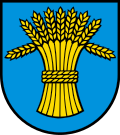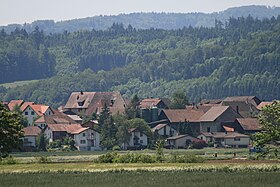Rüfenach
| Rüfenach | |
|---|---|
| State : |
|
| Canton : |
|
| District : | Brugg |
| BFS no. : | 4112 |
| Postal code : | 5235 |
| Coordinates : | 657 737 / 262 312 |
| Height : | 378 m above sea level M. |
| Height range : | 336-522 m above sea level M. |
| Area : | 4.17 km² |
| Residents: | 840 (December 31, 2019) |
| Population density : | 201 inhabitants per km² |
|
Proportion of foreigners : (residents without citizenship ) |
11.8% (December 31, 2019) |
| Website: | www.ruefenach.ch |
|
Rüfenach |
|
| Location of the municipality | |
Rüfenach is a municipality in the Swiss canton of Aargau . It belongs to the Brugg district and is just over two kilometers north of the district capital. Not to be confused with the town of Rüfenacht in the canton of Bern.
geography
The community extends at the northern foot of the Bruggerberg ( 516 m above sea level ) and the Reinerberg ( 516 m above sea level ), the southeastern foothills of the Table Jura . It consists of the three villages Rüfenach, Hinterrein ( 394 m above sea level ) and Vorderrein ( 397 m above sea level ). The last two villages mentioned formed the independent municipality of Rein until 1898 . The westernmost is Rüfenach, which lies in the middle of a wide Rüfenach plain. Hinterrein is slightly raised in the middle. To the east is Vorderrein on a protruding hill. The east side of this hill drops very steeply towards the Aare , the difference in altitude is around 70 meters. The municipality is drained by the Reinerbach .
The area of the municipality is 417 hectares , of which 171 hectares are forested and 49 hectares are built over. The highest point is at 522 meters on the Reinerberg, the lowest at 325 meters near the banks of the Aare near Vorderrein. Neighboring communities are Villigen in the north and north-east, Brugg in the south-east, Riniken in the south-west and Remigen in the north-west.
history
In 1914, during excavations in the center of the village of Rüfenach, the remains of a Roman estate came to light. Coins and various objects suggest that the complex was inhabited from the late 1st to the middle 4th century. Since the 8th century, Rein has been the center of a farm that belonged to the Murbach monastery in Alsace (at that time a farm was used to refer to the manorial rule over a larger area). In addition to Rein and Rüfenach, it also included the villages of Lauffohr , Remigen , Stilli and Villigen . Rufinach was first mentioned in a document in 1227. The place name comes from the late Latin (praedium) Rufinacum and means "the country estate belonging to Rufinus".
In the 13th century, the Habsburgs combined their sovereign rights west and north of Brugg in the Bözberg court. In addition to the above-mentioned villages, this also included Oberbözberg , Unterbözberg , Linn and Mönthal . In these villages, the Habsburgs exercised blood jurisdiction . King Rudolf I bought the Rein Hof in 1291 and was not only the chief judge, but also the most important landlord. In 1345 Queen Agnes of Hungary donated the farm to the Wittichen monastery in the Kinzig valley . From 1348 the court changed hands several times through pledging and in 1377 it finally came under the rule of Schenkenberg .
When the city of Bern conquered the area west of the Aare in 1460 , nothing changed in the rights of the monastery. However, the nuns had to accept the introduction of the Reformation in 1528. In 1544 the monastery sold the Rein farm to Count Hartmann von Hallwyl . In 1566 the judicial district of Bözberg was separated and the court cases of the Rein court were now heard in Stilli. Between 1588 and 1599 the city of Brugg acquired two thirds of the farm and Bern the remaining third. In March 1798 the French took Switzerland, ousted the «Gracious Lords» of Bern and proclaimed the Helvetic Republic . The Rein farm now belonged to the canton of Aargau. In 1799 the front line ran through the middle of the lower Aare valley during the Second Coalition War . There were several French army camps in the region. The villagers suffered great hardship through requisitions and looting.
In 1803 the canton of Aargau dissolved Hof Rein and raised the individual villages to independent communities. Around a hundred years later, the canton pursued an active merger policy and dissolved numerous small communities. Among other things, Rein should be merged with the municipality of Rüfenach. The residents of Rein resisted and took the case to the federal court , but without success: On January 1, 1898, the merger was completed. During the Second World War , the Rein-Roost blocking point of the 5th Division in 1939/40 was one of the most important sections of the Swiss Army's Limmat position . Rüfenach and Rein remained agricultural villages well into the 20th century. From the 1960s onwards, construction activity increased and the number of inhabitants increased by more than two and a half times.
Attractions
The 9th-century Rein church was once the center of an extensive parish and had Romanesque and Gothic elements. It had to be demolished in 1863 because of dilapidation. In its place, a new building in the style of historicism was built in 1864 according to the plans of the Zurich state architect Johann Caspar Wolff . In 1814 the cotton industrialist Johann Heinrich Meyer donated a poor house and orphanage, the Meyersche Anstalt . The facility in the style of rural classicism served as an observation station for the cantonal child and adolescent psychiatry from 1947 to 2016. The historic “Blauer Engel” inn got its current name during the Second World War, when the inn's daughter Anni Vogt entertained the soldiers billeted in the village in the blue Aargau costume.
coat of arms
The blazon of the municipal coat of arms reads: "In blue, yellow corn." The community seal from 1821 still showed a standing bull. The sheaf of corn appears for the first time on the seal from 1872 and indicates the agricultural tradition of the municipality.
population
The population developed as follows:
| year | 1764 | 1850 | 1900 | 1930 | 1950 | 1960 | 1970 | 1980 | 1990 | 2000 | 2010 |
| Residents | 124 | 370 | 266 | 283 | 272 | 334 | 450 | 518 | 624 | 727 | 867 |
On December 31, 2019, 840 people lived in Rüfenach, the proportion of foreigners was 11.8%. In the 2015 census, 42.3% described themselves as Reformed and 28.6% as Roman Catholic ; 29.1% were non-denominational or of other faiths. 94.9% said German as their main language in the 2000 census and 1.1% each Albanian and Portuguese .
Politics and law
The assembly of those entitled to vote, the municipal assembly , exercises legislative power. The executing authority is the five-member municipal council . He is elected by the people in the majority procedure, his term of office is four years. The parish council leads and represents the parish. To this end, it implements the resolutions of the municipal assembly and the tasks assigned to it by the canton. The Brugg District Court is the first instance responsible for legal disputes . Rüfenach belongs to the circle of judges of peace VIII (Brugg).
economy
According to the corporate structure statistics (STATENT) collected in 2015, Rüfenach has around 230 jobs, 18% of them in agriculture, 12% in industry and 70% in the service sector. Most of the employed are commuters and work in and around Brugg .
traffic
Rüfenach, Vorderrein and Hinterrein are accessed by side streets. The canton road 277 from Stilli via Remigen to Laufenburg leads a few hundred meters north past the villages. A post bus line from Brugg train station to Mönthal connects the community to the public transport network. On weekends there is a night bus from Brugg via Rüfenach, Villigen and Remigen to Riniken .
education
Rüfenach has a kindergarten and a school house in which the primary school is taught. All upper levels ( Realschule , Secondary School and District School ) can be attended in Brugg . The closest grammar schools are the Baden Cantonal School and the Wettingen Cantonal School .
Personalities
- Paul Haller (1882–1920), writer
literature
- Felix Müller: Rüfenach. In: Historical Lexicon of Switzerland .
- Michael Stettler , Emil Maurer : The art monuments of the canton of Aargau . Ed .: Society for Swiss Art History . Volume II: The districts of Lenzburg and Brugg. Birkhäuser Verlag, Basel 1953, DNB 750561750 .
Web links
Individual evidence
- ↑ Cantonal population statistics 2019. Department of Finance and Resources, Statistics Aargau, March 30, 2020, accessed on April 2, 2019 .
- ↑ Cantonal population statistics 2019. Department of Finance and Resources, Statistics Aargau, March 30, 2020, accessed on April 2, 2019 .
- ^ National map of Switzerland, sheet 1070, Swisstopo.
- ↑ Standard area statistics - municipalities according to 4 main areas. Federal Statistical Office , November 26, 2018, accessed on June 9, 2019 .
- ^ Martin Hartmann, Hans Weber: The Romans in Aargau . Verlag Sauerländer, Aarau 1985, ISBN 3-7941-2539-8 , p. 195-196 .
- ^ Beat Zehnder: The community names of the canton of Aargau . In: Historical Society of the Canton of Aargau (Ed.): Argovia . tape 100 . Verlag Sauerländer, Aarau 1991, ISBN 3-7941-3122-3 , p. 363-365 .
- ↑ Deborah Bläuer: The light is on in the abandoned building: What is going on in the former children's ward? Aargauer Zeitung , February 12, 2018, accessed on June 9, 2019 .
- ↑ The most traditional restaurant in the Brugg region. Blue Angel, accessed June 9, 2019 .
- ^ Joseph Galliker, Marcel Giger: Municipal coat of arms of the Canton of Aargau . Lehrmittelverlag des Kantons Aargau, book 2004, ISBN 3-906738-07-8 , p. 253 .
- ↑ Population development in the municipalities of the canton Aargau since 1850. (Excel) In: Eidg. Volkszählung 2000. Statistics Aargau, 2001, archived from the original on October 9, 2018 ; accessed on June 9, 2019 .
- ↑ Resident population by religious affiliation, 2015. (Excel) In: Population and Households, Community Tables 2015. Statistics Aargau, accessed on June 9, 2019 .
- ↑ Swiss Federal Census 2000: Economic resident population by main language as well as by districts and municipalities. (Excel) Statistics Aargau, archived from the original on August 10, 2018 ; accessed on June 9, 2019 .
- ↑ circles of justice of the peace. Canton of Aargau, accessed on June 18, 2019 .
- ↑ Statistics of the corporate structure (STATENT). (Excel, 157 kB) Statistics Aargau, 2016, accessed on June 9, 2019 .








